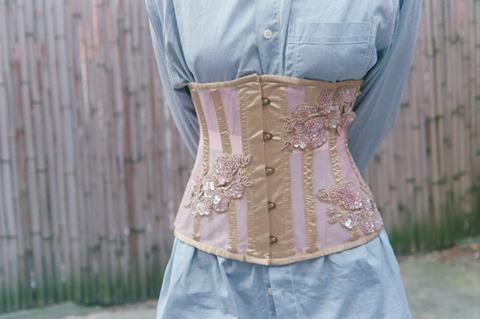Jenny Sanders explores the growing trend of rib removal surgery in pursuit of the perfect waistline. She asks what Eve — and God — might say about our obsession with physical perfection.

Forget filler and liposuction, ‘waist training’ is back on the beauty menu as women strive for the perfect hourglass waistline. Blame Bridgerton, The House of Guinness or The Forsythe Saga, but silhouettes are under the spotlight again.
Also forget crunches and twists. Cut (literally) to the chase and remove a rib or two to reduce your girth and reveal a silhouette to make everybody – yourself included – gasp. A national newspaper recently reported that this operation is increasingly popular in pursuit of the female ideal.
Fashion is fickle; concepts change cyclically. For example: Reubens’ voluptuous women in his sensual Baroque paintings illustrate their wealth and fecundity; a contrast with the contemporary poor. Almost 400 years on, of the 198 catwalk runways, 97.1% carried designer looks using UK size 4 models last year.
Costectomies require general anaesthetic and surgical incisions to access and remove ribs
Costectomies require general anaesthetic and surgical incisions to access and remove ribs 11/12 which are ‘free floating’ (ie don’t meet at the back). We generally have twelve sets of twenty-four ribs (males having only eleven is a myth) which serve to protect our vital organs, particularly the heart, lungs and spleen. They also protect the chest cavity from collapsing when we breathe in (diaphragm contracts and lungs expand).
READ MORE: Katie Price and cosmetic procedures: what can Christian women learn about when it is enough?
Removing ribs is usually only done to correct scoliosis, access a tumour or, in the (unusual) case of tracheal (windpipe) collapse. The first costectomy was performed over one hundred years ago. Little has changed. Surgeons still use a flexible saw to cut through the ribs before stitching the incision. A four to six week recovery period is recommended, during which time there may be bruising, swelling and itching.
Such invasive surgery is a controversial option for the sake of perceived beauty. One New York magazine recently advocated it as a figure-enhancing practice priced at almost $10,000. Major operations carry inherent risks of infection, bleeding and complications, but a costectomy also risks damage to those all important internal organs. Is it really worth it?
READ MORE: ‘What does the cosmos have to do with your cosmetics?’
Eschewing small waists and relinquishing the corset was once a symbol of female empowerment as women broke out of conventional dress, embraced the vote, employment and their emancipation. It seems strange that in the twenty-first-century some women are literally or metaphorically lacing themselves back in to it, conforming to that image of female fragility so beloved of times gone by.
To what lengths should we go as Jesus-followers to beautify ourselves?
To what lengths should we go as Jesus-followers to beautify ourselves? There are treatments and ‘tweakments’ galore on offer. Should we resist them all, assured that God made us as we are and that’s that, as if we have no responsibility? Time and life take a toll on our bodies. Do we just accept that? How responsible are we? Should we embrace every new fad to which capricious and changing shape of fashion invites us?
Like so many things, there’s a balance which includes taking responsibility for how we nourish, exercise and use our bodies. This is a matter for your own conscience and wallet. Genesis tells us that God shaped Eve from one of Adam’s ribs. She was the pinnacle of creation. Only when Eve came to Adam did God declare that His ‘good’ creation was now, ‘very good’ (Genesis 1:31).
READ MORE: Kylie Jenner has dissolved her fillers – is this a step toward freedom?
The Apostle Peter in his first letter to believers wrote: ‘What matters is not your outer appearance—the styling of your hair, the jewelry you wear, the cut of your clothes—but your inner disposition. Cultivate inner beauty, the gentle, gracious kind that God delights in’ (1 Peter 3:3–4 MSG). Scripture places more emphasis on inner beauty than outward appearance – remember, God looks on the heart (see 1 Samuel 16:7).
One secular reporter put it this way: ‘If thousands of years of getting dressed and painting our faces tells us anything about the human condition it’s that as a species, we’re vulnerable to ideals that, carried through to their logical conclusion, tend to be bad for our health and our happiness.’




































No comments yet